Easy Japanese Milk Bread (No Tangzhong Method)
Bake soft, fluffy Japanese milk bread (shokupan) at home with this no tangzhong recipe. The loaf stays tender for days and is perfect for sandwiches, toast, or enjoying warm from the oven.
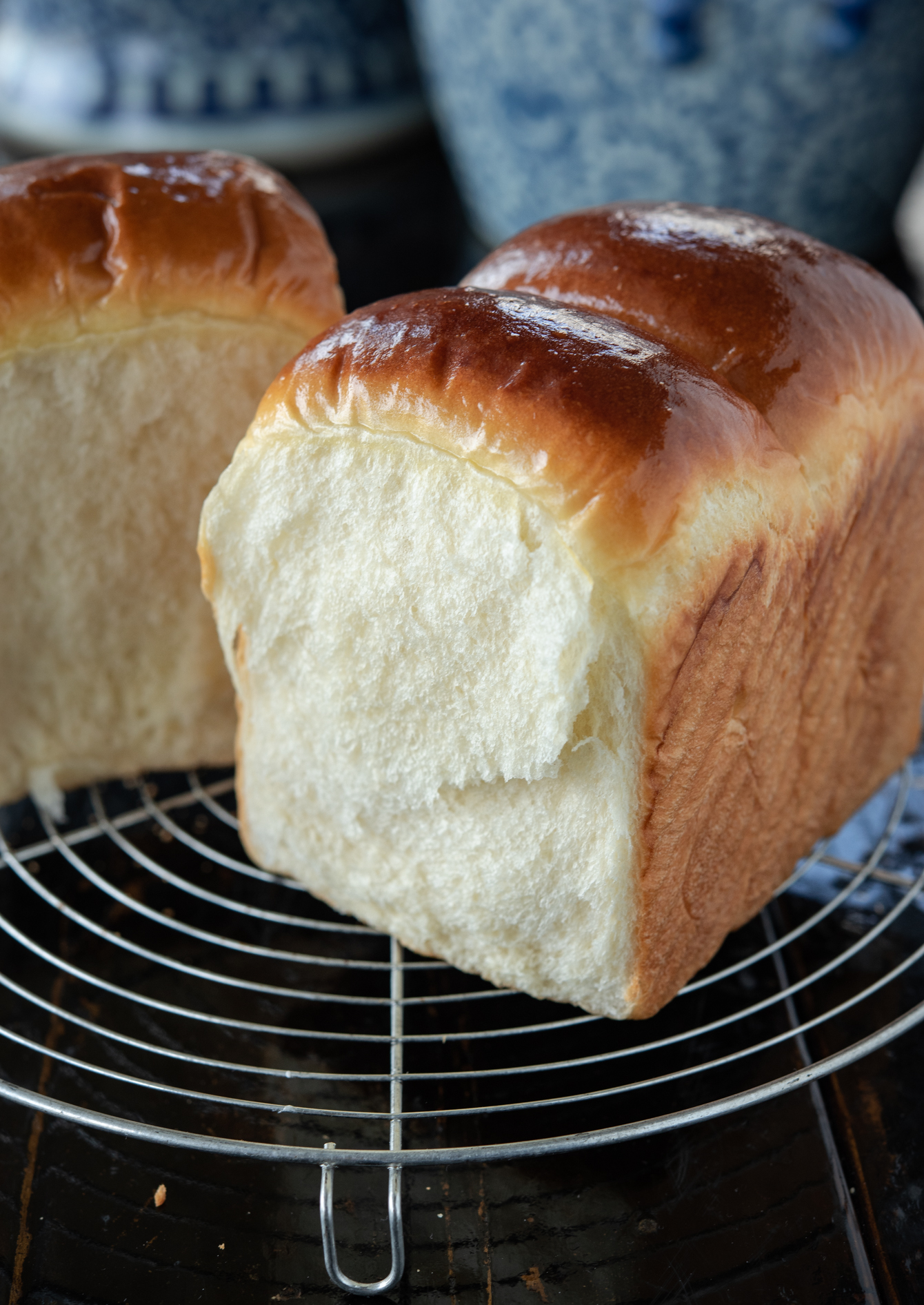
If you’ve ever strolled past a Korean or Japanese bakery, you know the irresistible pull of milk bread. Those golden loaves look simple, but the texture inside is what makes them unforgettable — feathery soft, cloud-like, and delicately sweet.
After testing many versions at home, I discovered that cream can do the work of tangzhong (a flour paste starter commonly used in Japanese shokupan or other Asian milk bread), giving the loaf its pillowy crumb without the extra step. It’s the method I rely on for bakery-style results every time — simple enough for beginners, yet impressive enough to give as a homemade gift.
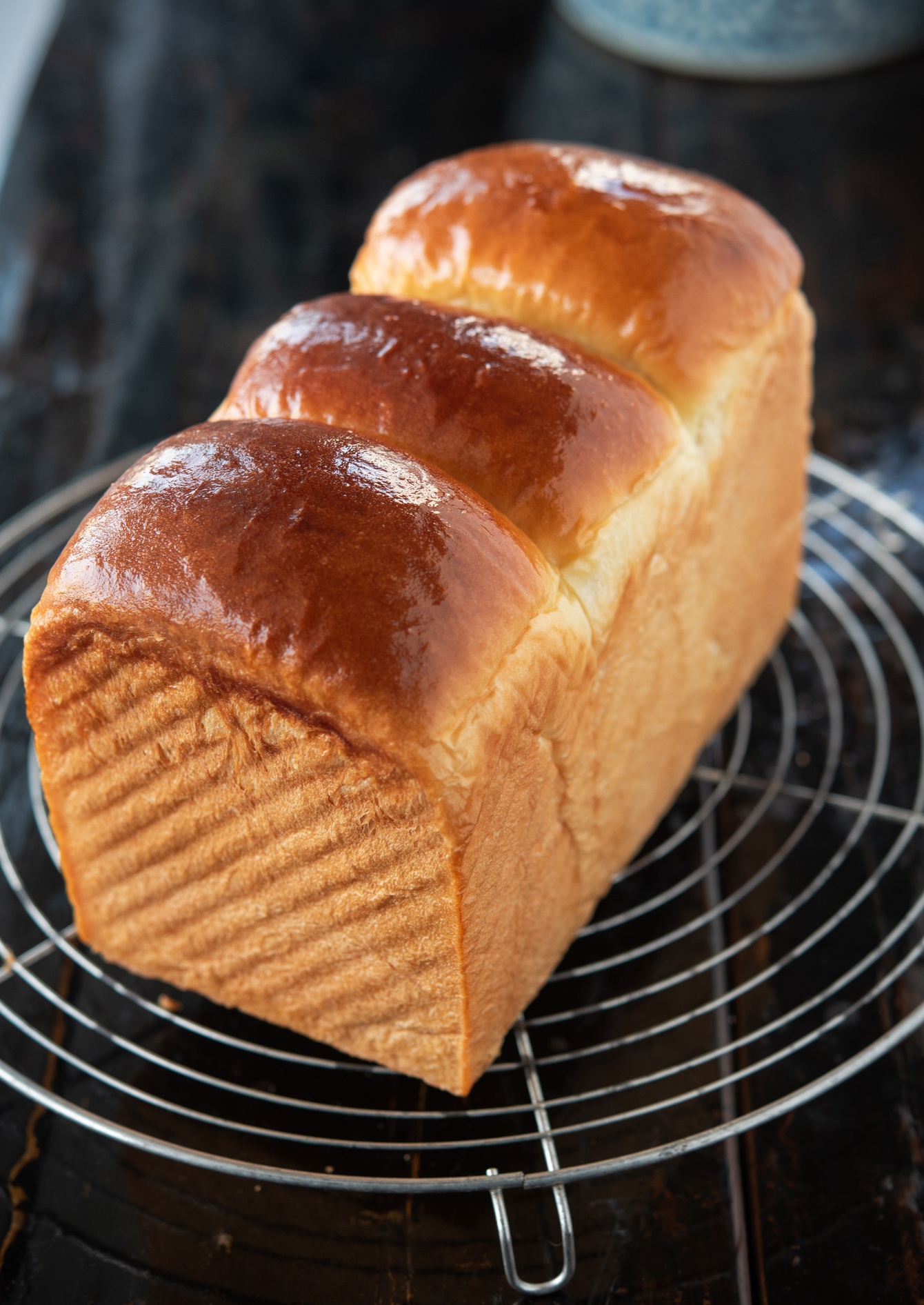
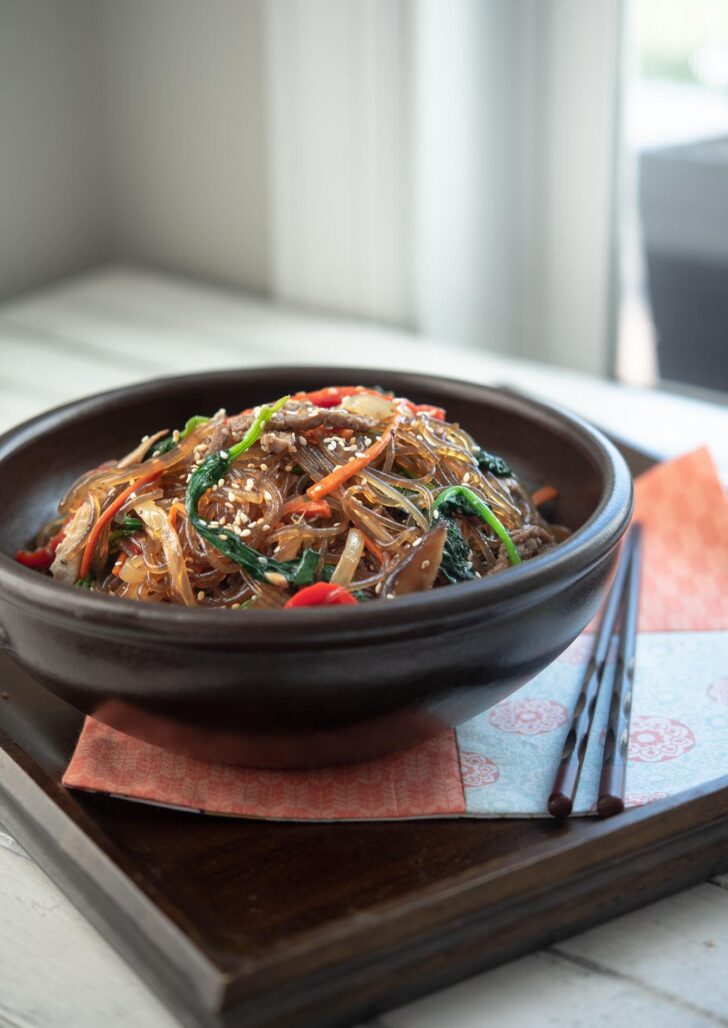
Get new recipes via email:
Why You’ll Love This Recipe
- No tangzhong needed: cream enriches the dough so you get that signature softness without an extra step.
- Beginner-friendly method: straightforward mixing and shaping that works whether you knead by hand or with a mixer.
- Bakery-quality results: the loaf rises tall, bakes golden, and stays tender for days.
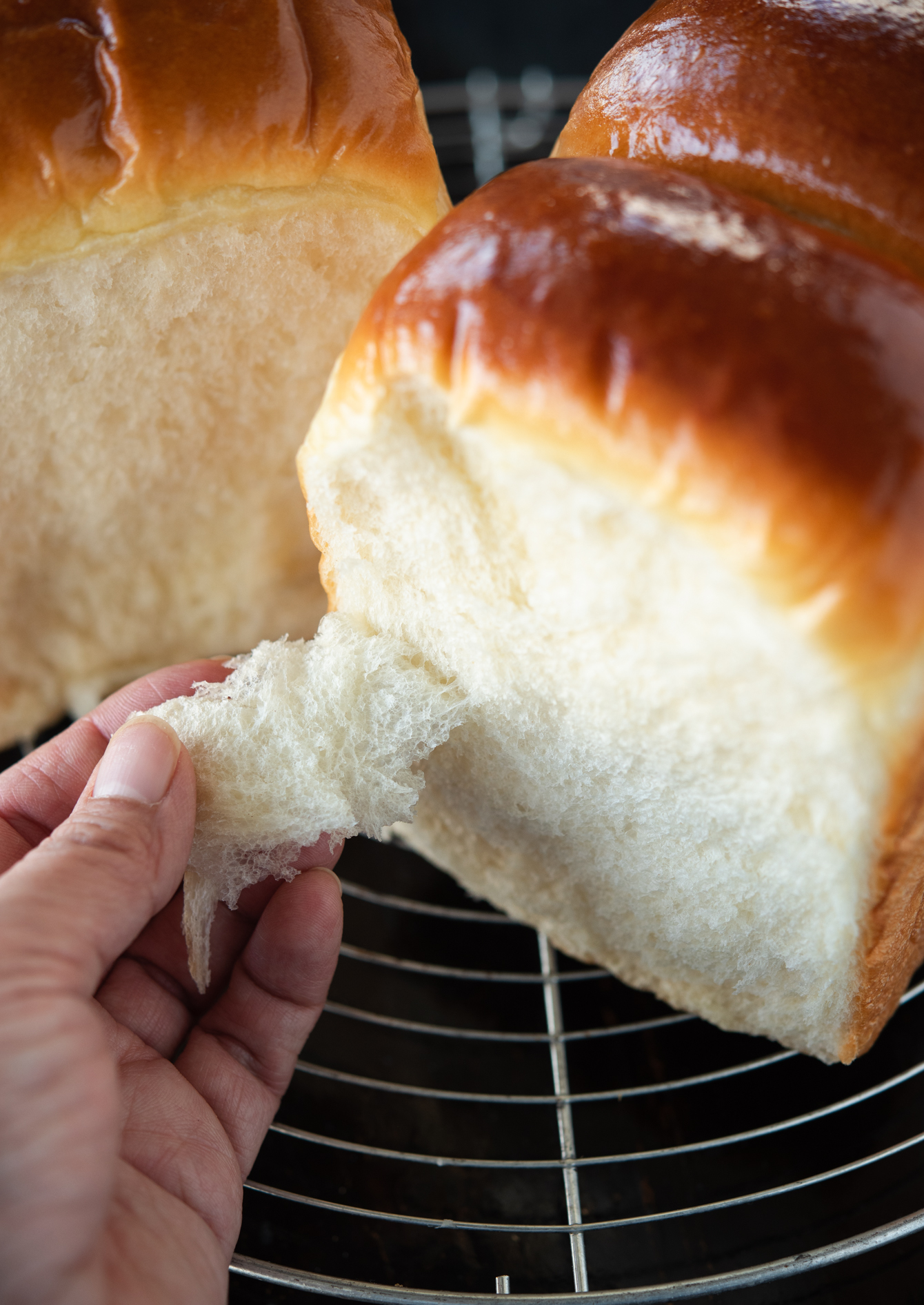
Key Ingredients for My No-Tangzhong Milk Bread
- Bread flour: I recommend bread flour over all-purpose because its higher protein gives the loaf that signature stringy pull when you tear it. If you only have all-purpose, it will still work — the bread just won’t be quite as chewy.
- Dry milk powder: This is the secret to bringing out that distinct “milky” flavor you taste in Japanese bakery loaves. I don’t skip it. If you can’t find it, substitute with an equal amount of additional flour, but know the flavor won’t be as rich.
- Heavy cream (or whipping cream): My twist. Instead of tangzhong, cream adds fat and moisture so the bread stays soft for days. I tested this recipe side by side with tangzhong, and the results were just as pillowy without the extra step.
- Milk: Whole milk gives the best balance of flavor and texture. If you use 2%, add a teaspoon more cream to make up for the lost fat.
- Yeast: I use instant yeast so I can add it straight to the dough. If you only have active dry, dissolve it in warm milk before mixing.
- Sugar & salt: Not just for flavor — sugar feeds the yeast for a strong rise, and salt controls fermentation so the loaf doesn’t overproof.

Step-by-Step: How to Make Milk Bread (No Tangzhong)
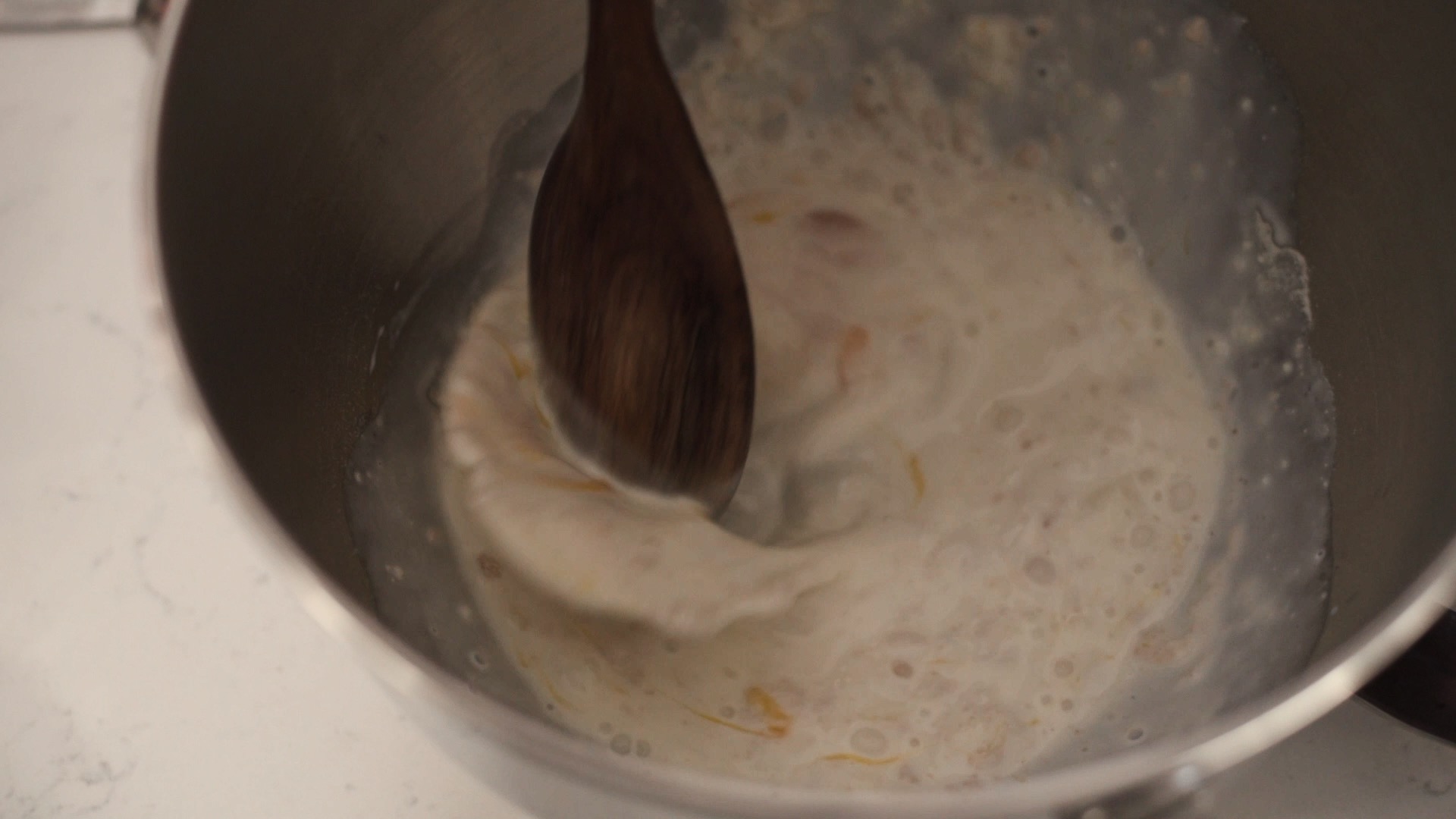
Mix & Combine Wet Ingredients: The dough will look loose and sticky at this stage — that’s normal and what gives milk bread its cloud-like crumb.
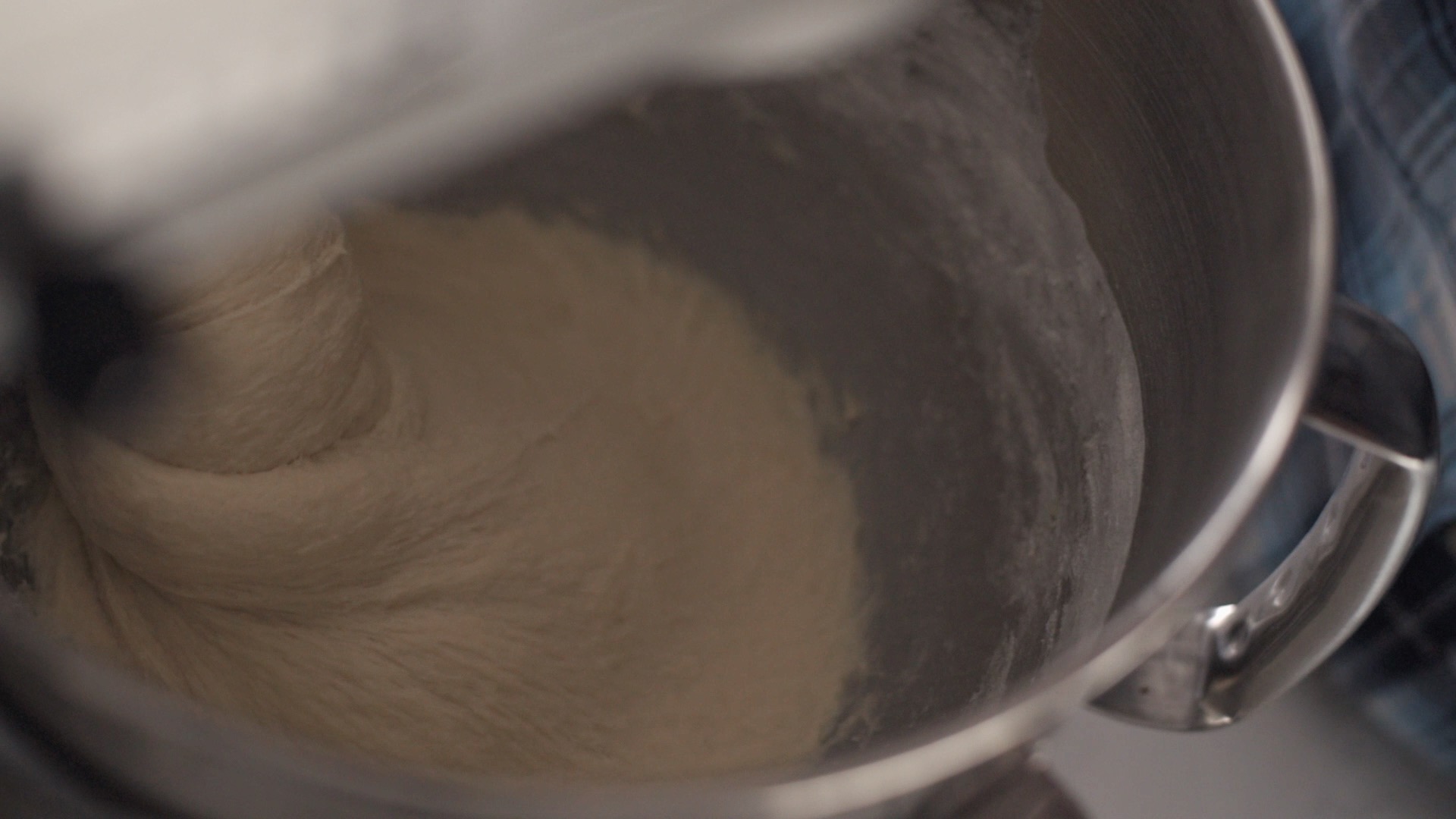
Knead Until Smooth and Elastic: Use a stand mixer if you can; if kneading by hand, expect the dough to feel tacky but it shouldn’t cling to your hands after 6–8 minutes.
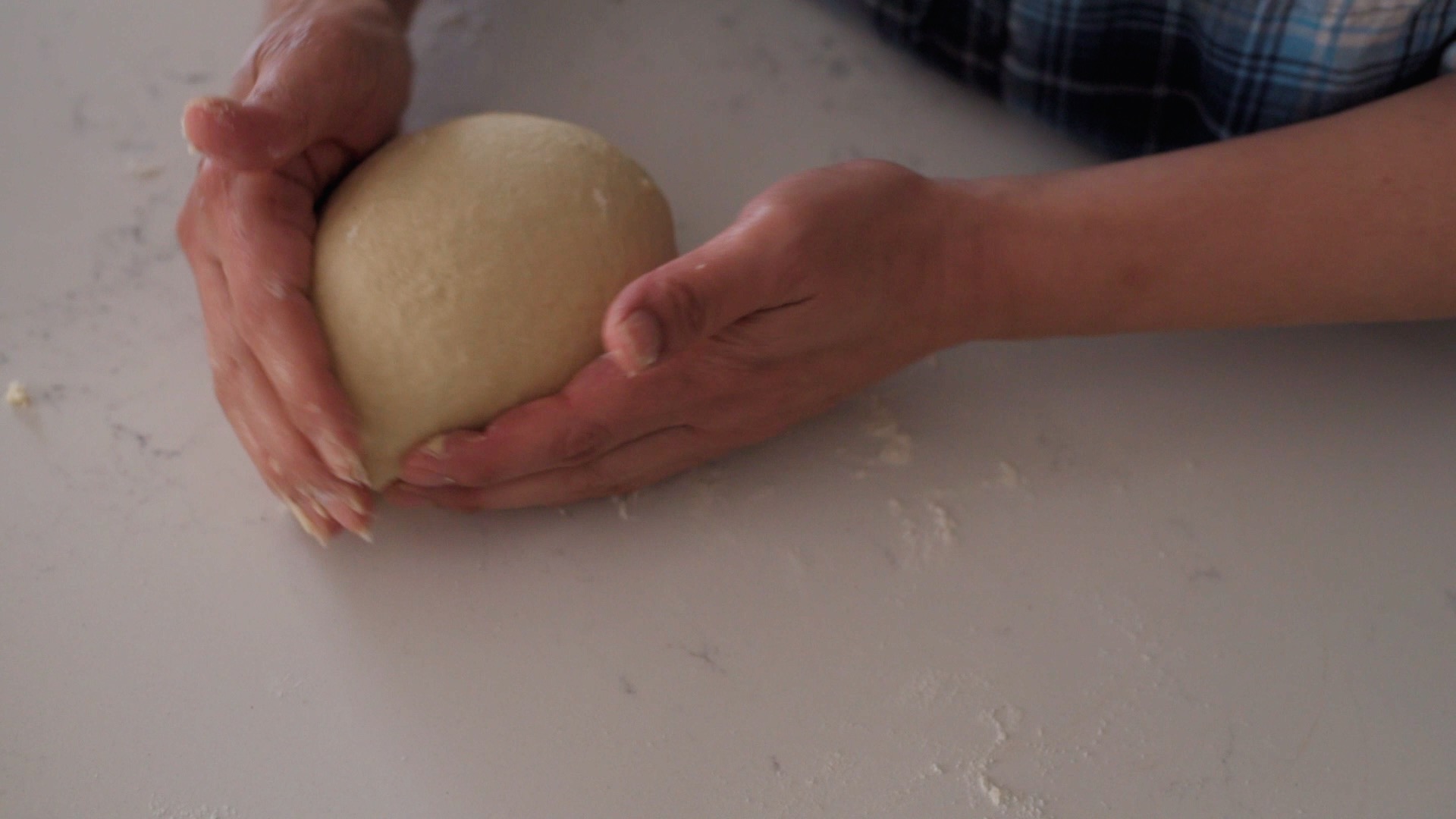
Let the Dough Rise in a Warm Spot: It should double in size. I usually proof mine in a turned-off oven with the light on — consistent warmth helps the yeast thrive.

Divide and Rest the Dough: Shaping starts with letting the gluten relax. Rolling too soon can tear the dough and give you uneven texture.
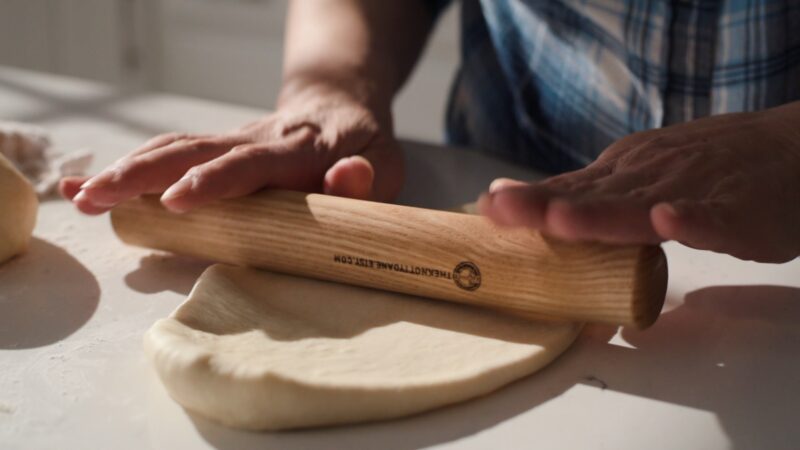
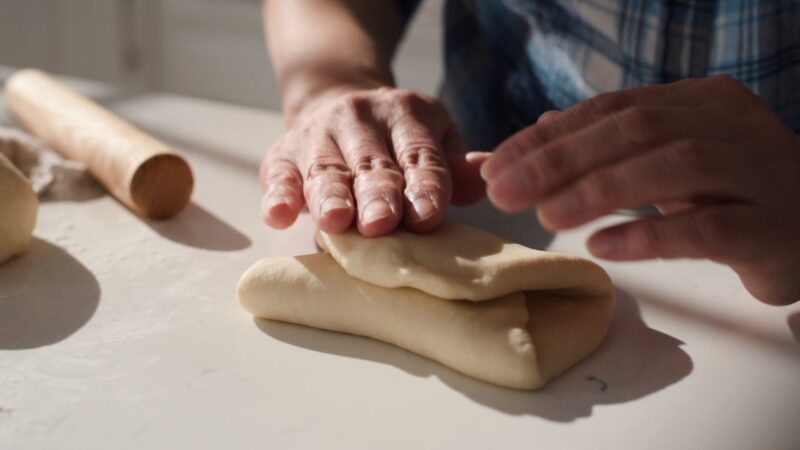
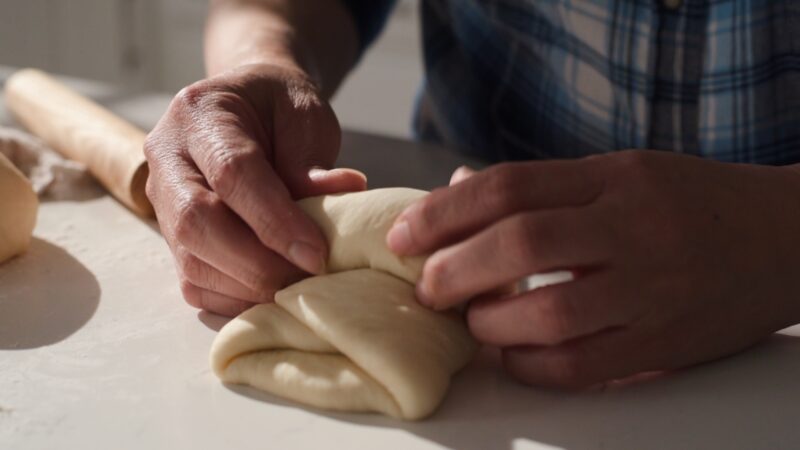
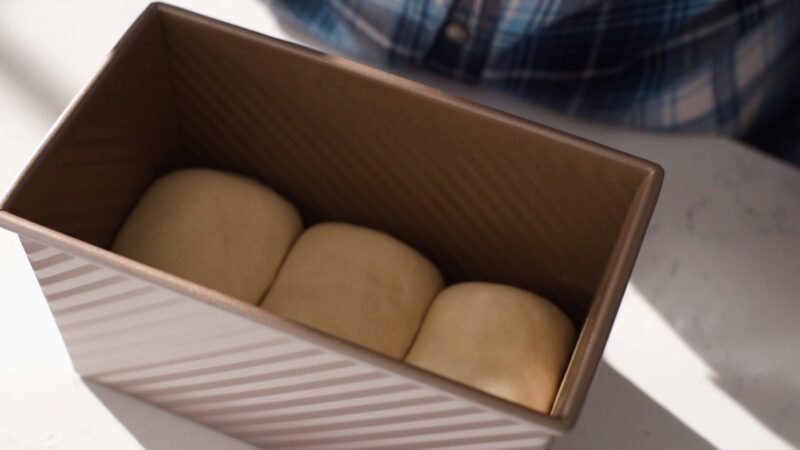
Roll and Shape for an Even Crumb: The “letter fold” method creates layers inside the loaf. Rolling tightly gives you that neat, bakery-style structure when sliced.
Second Rise: Patience Pays Off! Don’t rush this step — the dough should puff just above the pan rim before baking. Underproofing leads to dense bread.

Bake: An egg wash ensures a golden crust, then bake in a preheated oven at 350˚F (175˚C) for 22-25 minutes. If the tops brown too quickly, loosely cover with foil.
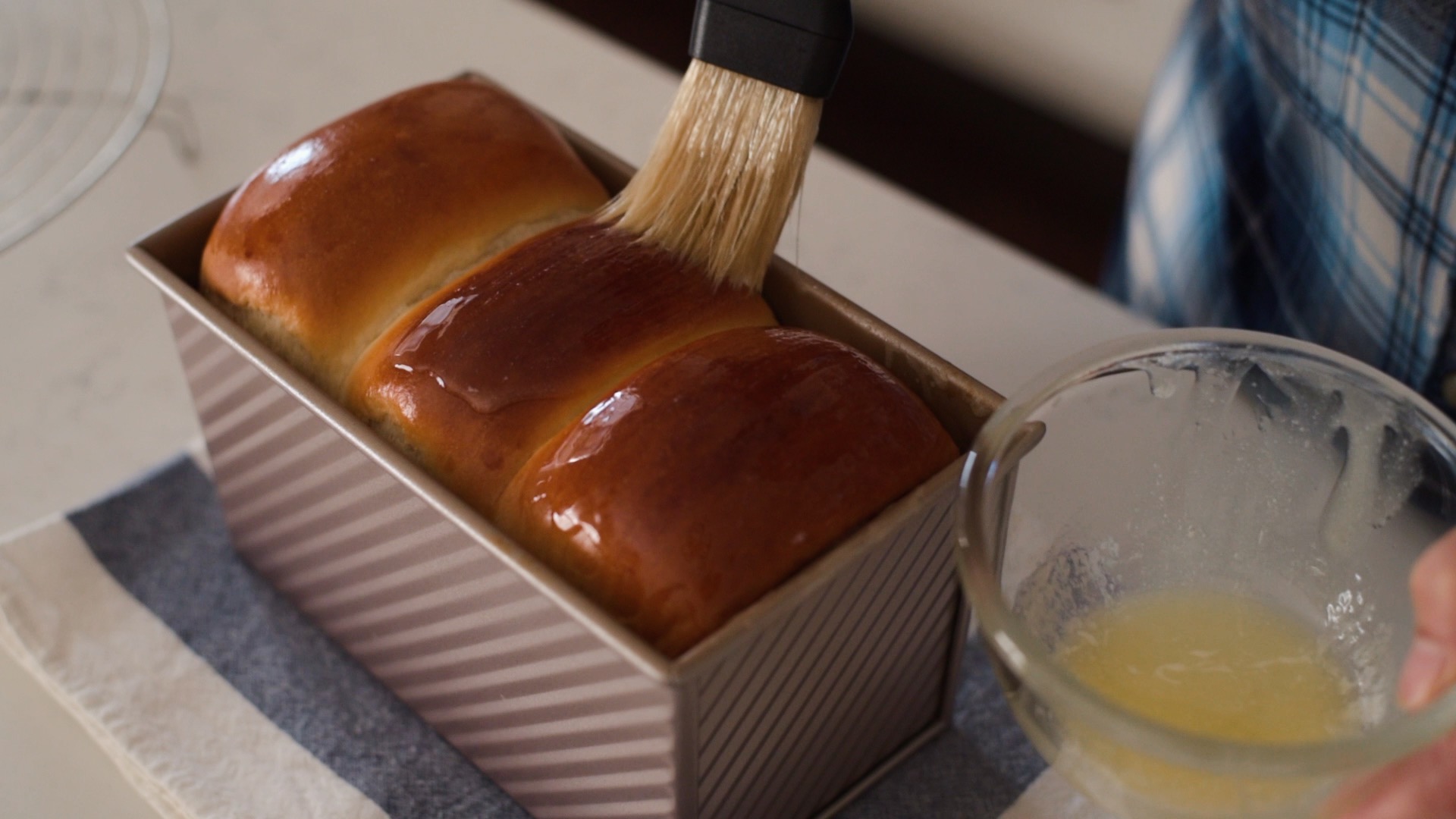
Finish with Butter: When the bread comes out of the oven, gently tap the pan once on the counter. This prevents the crust from sagging or wrinkling as it cools. Then brush the top with melted butter for a shiny, soft finish. Remove the loaf from the pan and cool it fully on a wire rack before slicing.
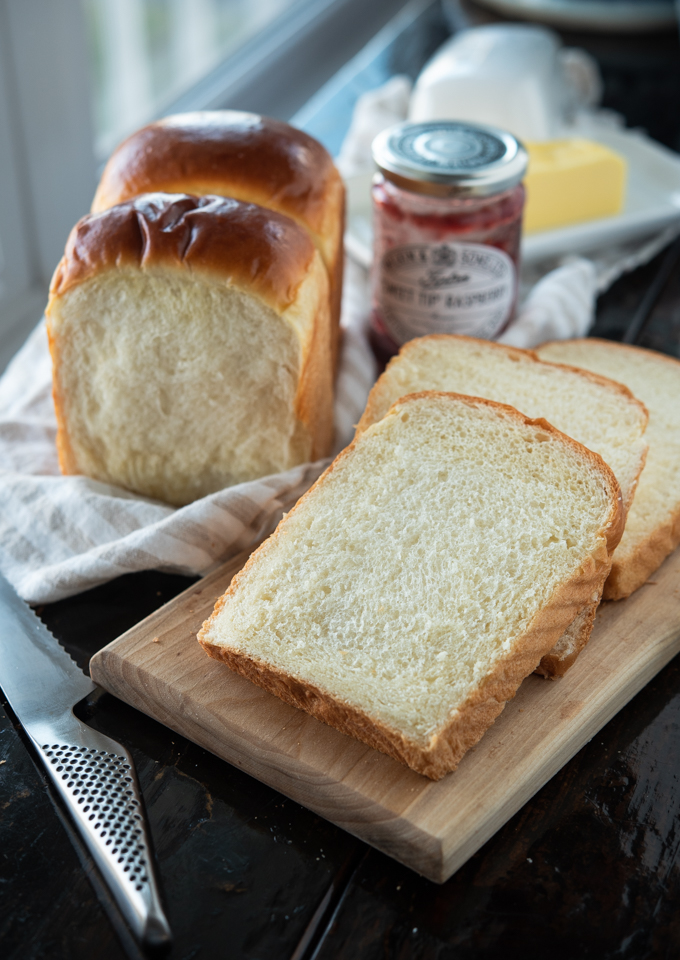
Serving Ideas
This Hokkaido-style Japanese loaf is wonderfully versatile — and it takes beautifully to a Korean twist.
Enjoy it warm with butter and jam; my Korean strawberry syrup is a favorite pairing. Lightly toasted slices are perfect for Korean street toast, a sweet-and-savory breakfast classic, or even a simple egg-and-cheese sandwich.
The soft, even crumb also makes tidy sandwiches, from ham and cheese to a creamy Korean potato salad sandwich
Storage Tips
Milk bread is best fresh, but it stays tender for several days if wrapped tightly or kept in an airtight container. For longer storage, freeze whole loaves or slices, well wrapped, for up to three months. To refresh, warm the bread briefly in a 300˚F (150˚C) oven until soft again.
Watch Recipe video
Love this recipe? Rate it and share your experience in the comments below! On Instagram? Tag me to showcase your creation. For more delicious recipes, subscribe to our newsletter!
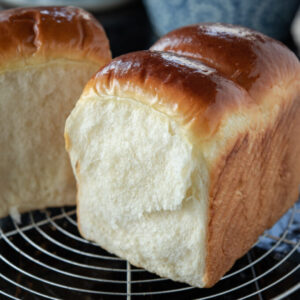
Easy Japanese Milk Bread (No Tangzhong Recipe)
Recipe Video
Ingredients
- 2/3 cup (160 ml) milk, lukewarm
- 1/3 cup (80 ml) heavy whipping cream, lukewarm
- 1/4 cup (50 g) sugar
- 1 egg, room temperature
- 2-1/4 tsp (7 g) instant yeast
- 2 tbsp (15 g) dry milk powder
- 1 tsp (6 g) salt
- 2-1/4 cup (300 g) bread flour , + 2-3 tbsp extra if needed
- egg wash (1 beaten egg with 1 tbsp water), for brushing
- 2 tbsp (30 g) melted butter
Equipment
- Pullman loaf pan See note below
Instructions
- Mix Ingredients: Using a mixing bowl from a stand mixer, mix together milk, cream, sugar, egg, instant yeast, powdered milk, and salt in a bowl. Add flour slowly and mix well to combine with wet ingredients using a wooden spoon.
- Knead: Using a dough hook, start kneading the dough on low(stir) setting for 12-15 minutes. If the dough seems too sticky, add 2-3 more tablespoon of flour as needed. Resist adding too much flour. The dough should be very sticky.
- First Rise: Turn out the dough on to a lightly floured surface, knead with your palm of your hand for 30 seconds. Shape the dough into a ball and place in a greased bowl. Cover and let it rise in a warm place until double in volume; about 1 hr.
- Divide and Rest: Punch the dough to deflate. Turn it out on to a floured surface and knead for 30-60 seconds. Dived the dough into 3 equal portions. Shape each portion to a ball. Cover and let them rest for 15 minutes so that the gluten can relax.
- Shape Loaf: Roll each dough ball into 7-8-inch long with a small rolling pin. Then flip the dough to the other side so that the smooth surface will face down. Fold it into thirds and rotate 90˚ degree so that the layered side is facing toward you. Start rolling the dough tightly and pinch the seam together to secure.
- Second Rise: Place the dough in a greased loaf pan. Press down the top with your hand gently. Cover and let it rise again until double in volume, about 40 minutes.
- Bake: Meanwhile, preheat the oven to 350˚F. When the dough is risen, brush the top with egg wash and bake for 22-25 minutes. If the top crust gets brown too quickly, loosely tent with a piece of foil.
- Finish: Remove the bread from the oven and tap the pan lightly on the counter to keep the crust smooth. Brush the loaf with melted butter, then cool completely on a wire rack before slicing
Notes
- This bread bakes beautifully in a Pullman loaf pan for that classic square bakery look. You can bake with or without the lid — lid for a flat top, no lid for rounded mounds. If you don’t have one, a standard 9×5-inch loaf pan works perfectly too.
- Milk bread stays soft for several days at room temperature. For longer storage, freeze whole or sliced loaves for up to 3 months. Reheat in a 300˚F oven until warm.

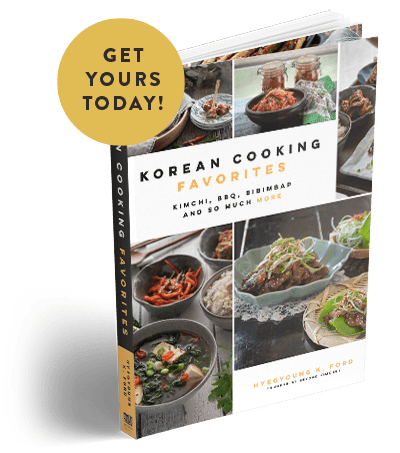
Followed and doubled the recipe. The loaves of bread were beautiful and have the perfectly soft milk bread texture. Recipe is a keeper. Thank you!
Hi Holly
I wanted to thank you for giving me the recipe for a larger loaf of bread. However, I found that you need to have six small rolls to put inside the 13 x 4 Pullman pan. And that it takes only 30 minutes to do the second rise, if you are using the top on the pan. And 45 minutes to bake. I also have a question can you make cinnamon rolls out of the bread recipe? Recipe is so good.
This milk bread recipe works great with cinnamon rolls. Hope you enjoy it!
This bread is delicious. It’s soft and taste great. I only have one problem and that is I want to make this bread in a 13×4 Pullman pan and I don’t know how to double the recipe. Can you please help me and tell me how I can do that?
Thank you
Hi Pamela,
This recipe is for one 1 lb loaf, and you can easily double it if you’re using a 13×4 inch pan, which is suitable for a 2 lb loaf. Here’s the adjusted recipe for a double batch:
1 cup milk
2/3 cup heavy cream
1/2 cup sugar
2 eggs
4 1/2 tsp instant yeast
5 tbsp milk powder
2 tsp salt
4 1/2 cups bread flour (plus an extra 3-5 tbsp if needed)
egg wash for brushing
4 tbsp melted butter
Follow the same instructions as for the single batch. Hope this helps!
Do I use the basic setting on the bread machine to do all the kneading and baking ?
I personally have not tried using a bread machine for this recipe, but it should work on the regular setting, just as it would for other types of bread.
It’s a bit sweet for me. I’d rather eliminate the sugar, or reduce it to a tablespoon.
Dough cycle on a bread machine worked for me. That cycle does the mixing and first rise (bulk fermentation). I then took it out of the bread machine and followed step 4 and onwards. If you want to use the bread machine to bake for you as well, which I wouldn’t recommend because it’ll lose its shape, then I’d use the sweet or white cycle. Just remember to take your paddle out on the bottom before baking. This is a GREAT recipe. I have used it multiple times, delicious!
Can I leave out the milk powder? What will it change?
I highly recommend adding the milk powder, as it not only enhances the milk flavor but also aids in the rising of the bread dough.
Can you add raisins to the bread?
Of course. It will be very tasty milk bread with raisins.
Can this recipe be doubled without changing any of the amounts? Just multiply all ingredients by ×2?
Thank you
If you want to double the recipe for milk bread, it should work fine. However, it’s a good idea to start with slightly less liquid and adjust as needed while kneading the dough. Keep in mind that the dough may be on the sticky side, but this stickiness should subside after rising. Hope this helps. Thanks!
Thank you very much for sharing this recipe which I am in the process of making. Unfortunately it came out really liquid and I had to add tons of flour🤷
Could you please advise on this, I understand that maybe the flour is different but I didn’t expect the dough to come out very liquid. I used bread flour and Canadian flour which is very high in gluten.
Thank you very much.
Costanza
Hi Costanza
Can you double check the amount of flour and liquid you used just to make sure? The dough is on the sticky side, but shouldn’t be like a liquid you are mentioning.
Was the melted butter just for greasing? Not for the dough?
Hi Yuri
Melted butter is for brushing the top of bread right after it comes out of oven. You don’t need it in the dough. Hope this helps. Thanks.
Hmm, have a recipe for that doesn’t need a mixer?
You can knead this dough by hand. It will be on the sticky side but it will hold its shape as you knead. Add a little more flour if needed.
Thanks. Just not a fan of kneading. Like the no mess approach.
I have no cream, is it ok to use all milk will it come out the same, thanks much in advance, just waiting to see before I do another batch,
You will need extra fat to make the bread extra tender and soft. So I highly recommend adding the cream.
I have to say I have made this bread a dozen times and this last time was perfection, I posted on FB, which I never do for food items, and gave your Pinterest recipe that I have saved to mine to 6 people. Quick question the rise this this time was like the yeast was on steroids, I ran out of bread flour and wanted to make two loaves, so I used maybe 2 cups and the rest I used hi Gluten, could this be why I had so much over spring which I never get, running out gave me a loaf that was amazing, and the dough to work with was fantastic, what do you think thanks much
Hi Ileen
I am so glad you like my bread recipe.
Yes, high gluten flour tend to absorb more liquid than regular flour so it effect the rising faster.
Thanks.
Can you make this in not the 3 sections, love the bread, made a dozen times. I think without separations would be better for sandwiches
Yes, you can roll the dough into a large single section without dividing into 3 small sections. Just make a large flat square dough and roll it up to fit into your pan.
Glad to hear you like this bread. Thanks.
Hi..what do I do if I want to substitute for the egg? Thanks
Hi Jayanti
Try with 1/4 cup of mashed banana or sweet condensed milk per egg. Hope it works out for you.
This is a great recipe, I do it on the dough cycle in my bread machine. Just add the ingredients in the order that you normally would for a bread machine. I prefer to use active dry yeast which needs to proof first in the warm liquid and sugar but I did try with the instant yeast and it worked out too.
So happy to hear it worked out great for you with a bread machine. Thank you for the comment.
Hi, may I replace heavy cream with non-diary whipping cream?
Yes, it should work fine.
Did you use a lid for your Pullman loaf pan?
No, I didn’t.
Could this be made in a breadmachine??
I haven’t tried in a bread machine, but I think it will work. Let me know how it turns out.
I made the dough in the bread machine then rolled it by hand and rose it in a pullman. I think the powdered milk is essential. But the cream can be replaced with 60g of melted butter.
This is actually the first bread I’ve ever made (besides things like banana bread ahaha) and it turned out perfectly! I’m soooo happy, thank you for the easy to follow instructions 🙂
I didn’t have any bread flour and neither did my local Target, so I just used all purpose flour and kneaded a bit longer to really get the gluten activated. It worked great!
So glad to hear this bread turned out well for you. It is, indeed, an easy recipe and the outcome is very satisfying. I make it quite often when I am in the mood for feather light white bread.
How can I make this by hand kneading….I do not have a mixer
Hi Marva
Try kneading the dough by hand for 7-8 minutes. The dough is on the sticky side. You can add a little more flour as you knead but not too much. You can grease your hand with a little bit of oil if the dough sticks too much to your hand. Hope this helps.
Hi Holly,
Thanks for sharing your recopie. I love in Australia and they don’t sell heavy whipping cream. Either thickened cream or fresh cream/double cream. Any advice on that?
Hi Sophie
I would choose double cream. Although double cream has higher fat content than heavy/whipping cream, it should work with this recipe. Use the same amount.
Hope you succeed and let me know how it turns out.
Hi, Holly! If I wanted to make this bread square with the Pullman lid (like for sando), do I still follow the same directions? Thanks!
I think it will work but the bread might be slightly compressed with a lid on. I would try first to see how it turns out. If it gets too dense, try with a little less dough next time. It is a really easy yet fluffy milk bread recipe and I was very happy for the outcome. Good luck! Thanks.
Ohhh what a wonderful recipe. Every Day I eat a bread :).
I’m a little confused. In your description you say “whipped cream” but in your recipe it says “heavy whipping cream lukewarm”. Should the cream be whipped first before using?
Sorry to confuse you. It should be just un-whipped heavy whipping cream. Make sure to warm it slightly.
Can you substitute anything for whipping cream? I don’t keep that on hand.
You can try with milk and melted butter mixture, about 4 tbsp milk + 1.5 tbsp butter.
This is gorgeous! Love the texture of it — so light and fluffy. Really terrific recipe — thanks.
It turned out so soft and airy…perfect!